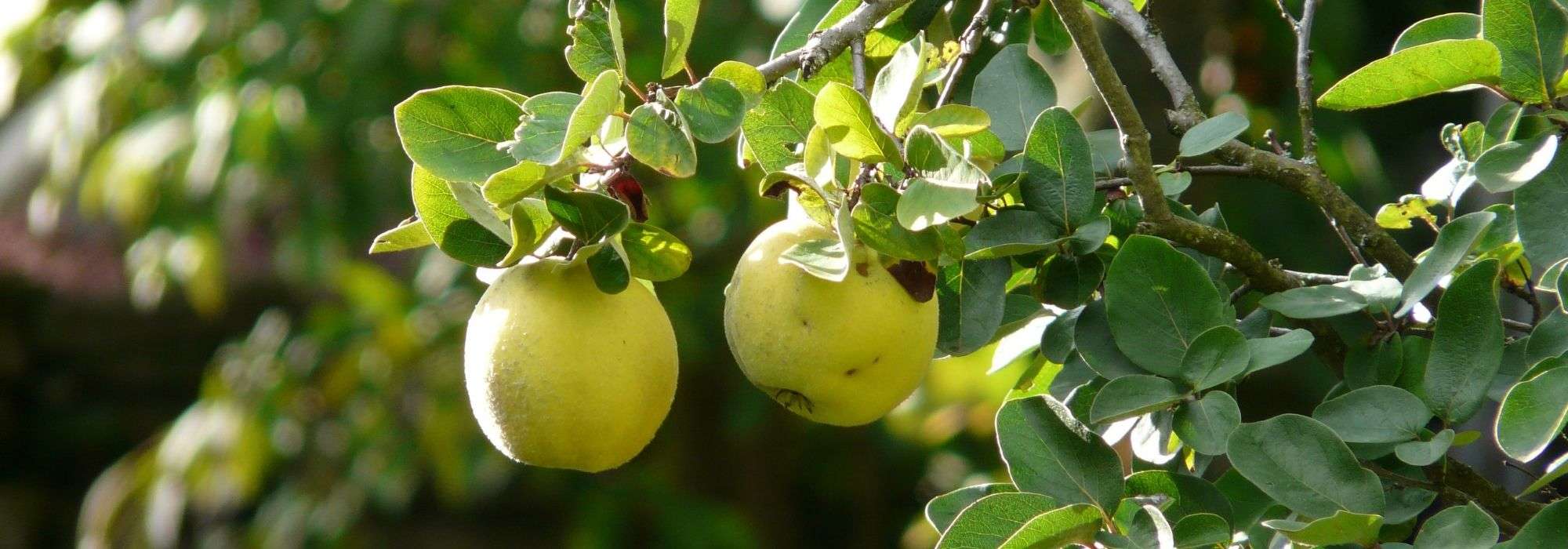
Quince tree: planting, pruning and care
Contents
Quince tree, in a nutshell
- Robust fruit tree, low-maintenance, easy to grow in any region.
- Displays very romantic pale pink flowering in May on dark green ovate foliage.
- Quince tree produces large cooking fruits with golden-yellow skin, quinces used to make jellies or quince paste.
- Prefers full sun and fairly cool soil.
A word from our expert
Quince tree, sometimes called “quince tree” is a small tree with a rounded habit perfect both for decorating the garden, providing shade and producing fruit. It is a hardy tree, able to withstand severe frosts of around -25°C but which hates summer humidity. Such a climate indeed favours the development of entomosporiose, a disease that spots leaves and fruit. The quince likes sun, any deep, cool soil, which is why it is common in southern France although found throughout the country and in many regions of the world.
It bears a magnificent spring flowering with large flat pale pink, delicately scented flowers that stud its young light green foliage in April or May. This very fertile tree is much easier to maintain than an apple tree: no need to prune to encourage flowering or to treat repeatedly. Its fruits, called quinces, are not only very decorative with their golden skin and large pear-shaped form but also excellent to eat, even if they sometimes harbour a few worms. They are picked at the end of summer when they give off a subtle perfume and when the fuzz on the skin comes away when rubbed by hand. These fruits are not eaten fresh because their flesh is very hard and acidic but they make delicious compotes, jellies, jams, mixed with apples which they enhance in flavour and, of course, excellent fruit pastes. The flesh oxidises quickly once the skin is removed but without altering the flavour.
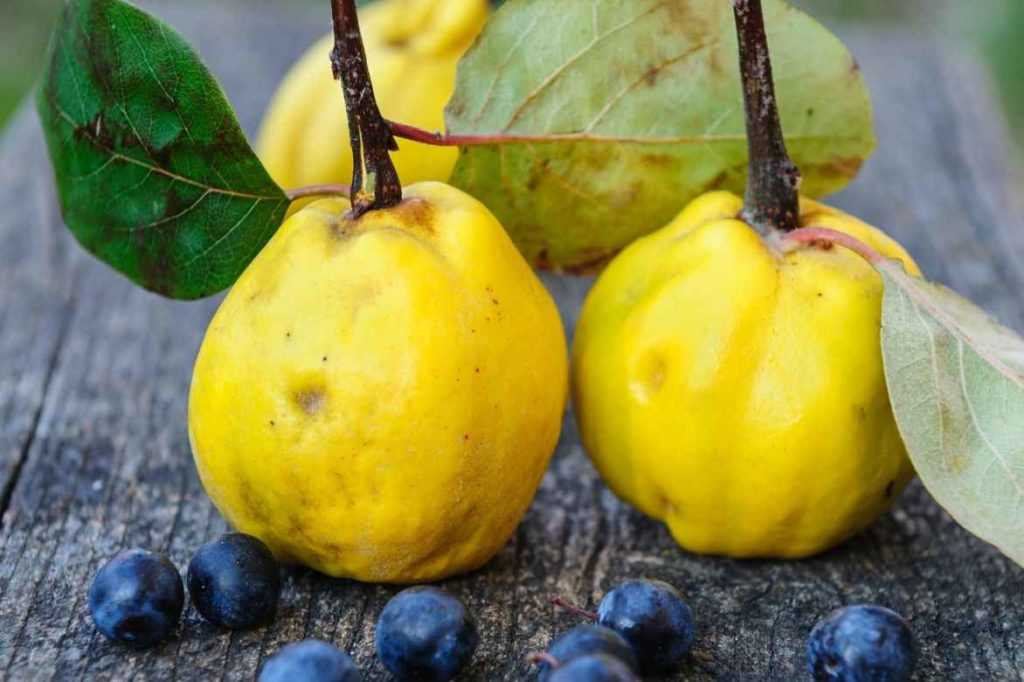
Description and botany
Botanical data
- Latin name Cydonia oblonga
- Family Rosaceae
- Common name Provence quince, Golden apple
- Flowering between April and May
- Height between 3 and 4 m
- Sun exposure sun or partial shade
- Soil type any deep, fresh soil, even slightly calcareous
- Hardiness Excellent (-25 °C)
Cydonia oblonga is sole species of genus Cydonia belonging to family Rosaceae like many of our fruit trees (apple trees, pear trees, cherry trees, apricot trees, plum trees…). Do not confuse it with Japanese quince (Chaenomeles japonica), which forms a thorny shrub with early flowering, usually red in March, and which sometimes produces edible quinces a little smaller than those of the fruiting quince.
The term Cydonia corresponds to name given to this tree and to its fruit by the Romans, also called Cydon apple, Cydon being a town in Crete. Species name oblonga refers to oblong shape of leaves, longer than wide.
Quince tree forms a small rather gnarled tree with spreading bushy habit, 4 to 8 m high. It is native to cool temperate regions of the Caucasus and Iran and in France it has mostly naturalised in southern France. It grows at edges of leafy forests, in hedgerows or on banks of streams or ravines on fresh soil.
Young shoots are covered with a fine ashy-grey or yellowish down while bark of trunk forms a pretty patchwork of rose‑grey‑beige patches.
Deciduous leaves are alternate, entire, borne on a short petiole and are sometimes pendulous as in variety Champion. Lamina is ovate, measuring 5 to 10 cm long by 3 to 8 cm wide and is flanked by stipules that fall fairly quickly. Underside of lamina is very whitish downy while upper surface is generally glabrous and dark green. Foliage takes on beautiful golden autumn hues. Leaves are grouped on a short spur at the tip of which a solitary flower opens while long leafy shoots grow during summer.

Cydonia oblonga – botanical illustration
Scented flowering appears in April–May, during which crown becomes covered with a cloud of upright pink buds set against light green foliage. Calyx is formed of 5 triangular, dentate green sepals, often reflexed towards the peduncle, while a broad flat corolla, 3 to 5 cm in diameter, displays 5 rounded petals, white washed with pale pink. Numerous stamens surround the 5 pistils fused at the base.
Fleshy fruit, covered with a down that rubs off when fruit is ripe, is globose or pear-shaped (pyriform) depending on variety, measuring on average 10 cm long by 8 cm wide and weighing between 300 and 1500 g in variety ‘Monstrueux de Vranja’. Flesh generally very firm even at ripeness, contains mucilaginous brown or black pips, since it is indeed a pip-bearing fruit. Raw fruit is very aromatic but astringent in flavour, except for some Mediterranean varieties, so it was used to scent wardrobes. Fruit is rather eaten with plenty of sugar after slow cooking, which produces that famous quince paste, rich in vitamins and fibre with digestive, tonic and anti‑diarrhoeal properties. Quince is of course enjoyed in pastries but also in savoury dishes just like apple. Mucilaginous pips have anti‑inflammatory properties for eyes and are emollient.
Quince tree has a hard wood veined with blond and fragrant, prized for marquetry and for making stringed instruments.
Wild quinces, Provence quince (drought‑tolerant) and Angers quince (less vigorous) are used as rootstocks for pear trees and for cultivated quince varieties. They are not very susceptible to woolly aphids.

Cydonia oblonga: flowers, fruits and bark
Main quince varieties
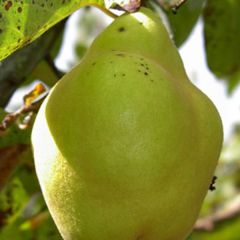
Quince Champion - Cydonia oblonga
- Flowering time May, June
- Height at maturity 4 m
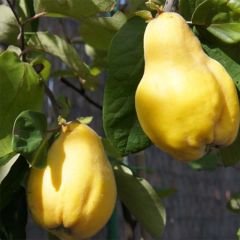
Cydonia oblonga Vranja
- Flowering time May, June
- Height at maturity 4 m
Discover other Quince trees
View all →Available in 1 sizes
Available in 2 sizes
Available in 1 sizes
Available in 2 sizes
Available in 2 sizes
Available in 1 sizes
Available in 1 sizes
Available in 2 sizes
Available in 1 sizes
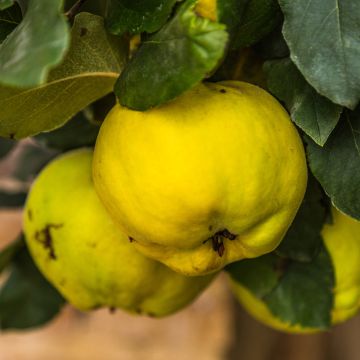
Available in 1 sizes
Planting
Where to plant the quince tree?
Quince tree is not demanding regarding soil type whether neutral, slightly acidic or calcareous (up to 7–8% active limestone) provided it is deep and cool at depth. Fruit set is more irregular in the presence of limestone or in dry soil. It prefers a fertile, light soil.
Choose an open site, in full sun to partial shade and, if possible, sheltered from cold winds. Varieties with early flowering in April may suffer from late frosts, which can compromise fruiting.
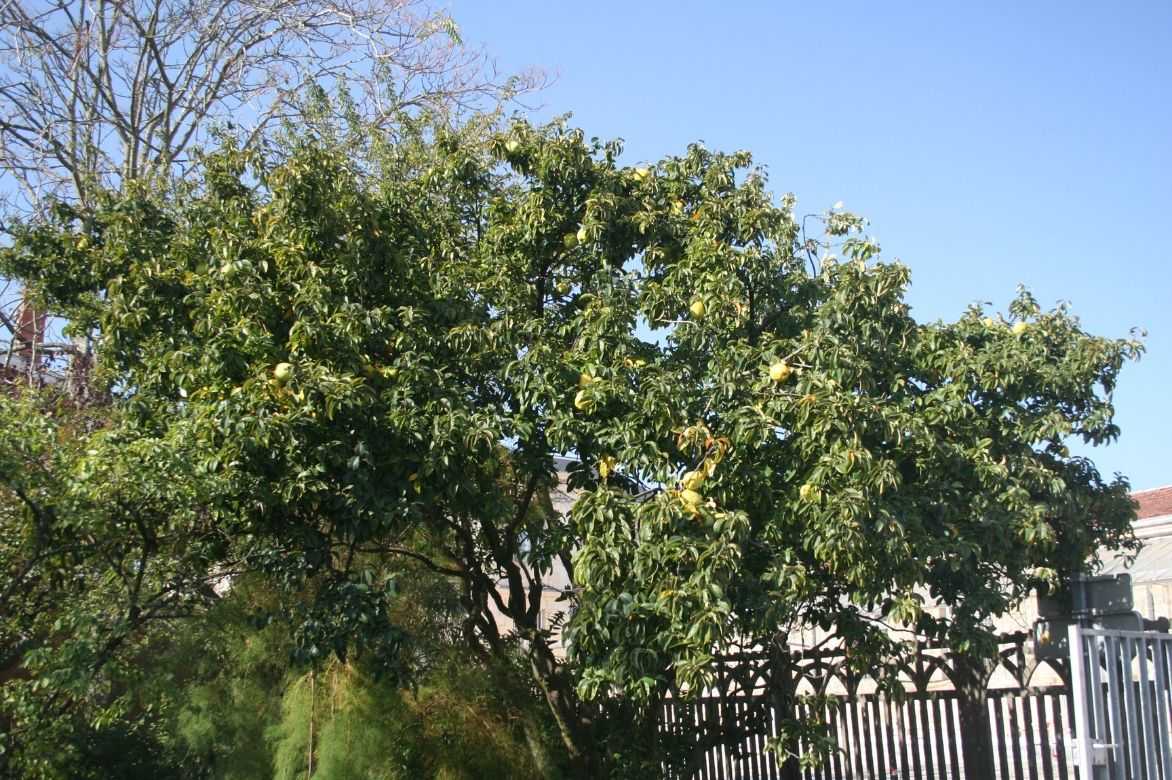
Space trees 4 to 6 m apart in an orchard but you can also incorporate the quince tree into a mixed hedge or a fruit hedge, or train it as a palmette against a wall.
When to plant?
Prefer planting in autumn–winter, especially if the young plant is sold with bare roots and during frost-free periods.
How to plant?
This plant is easy to grow.
- For a young plant in a pot, immerse the root ball in a bucket of water to thoroughly moisten it, or if it is a scion with bare roots, neatly trim damaged roots then coat them with pralin or, if unavailable, with mud.
- Work the soil by removing stones and undesirable herbs,
- Using a spade, dig a hole 50 to 60 cm in every direction, avoiding smoothing the sides. Be sure to place subsoil to one side and topsoil to the other.
- To enrich and lighten the soil, add horn meal, base fertiliser and well-rotted compost or potting compost with the subsoil, and put this mixture at the bottom of the planting hole.
- Drive 1 to 3 stakes in, set back from the position of the root ball.
- Place the young plant level so that the collar is flush with the soil surface, then backfill with the topsoil, forming a saucer.
- Pour a full watering can to firm the soil and expel air bubbles.
- Attach the stake to the trunk, crossing the tie in a figure-of-eight without touching the trunk.
Quince tree care and pruning
- Water regularly during first years after planting and in case of hot weather.
- Maintain a mulch of dead leaves, straw, B.R.F. or half‑decomposed compost to avoid competition from weeds.
- Apply compost at the crown’s drip line each autumn to maintain soil fertility.
Quince tree is quite susceptible to entomosporiosis, a fungus that forms brown spots on leaves during humid springs and summers.
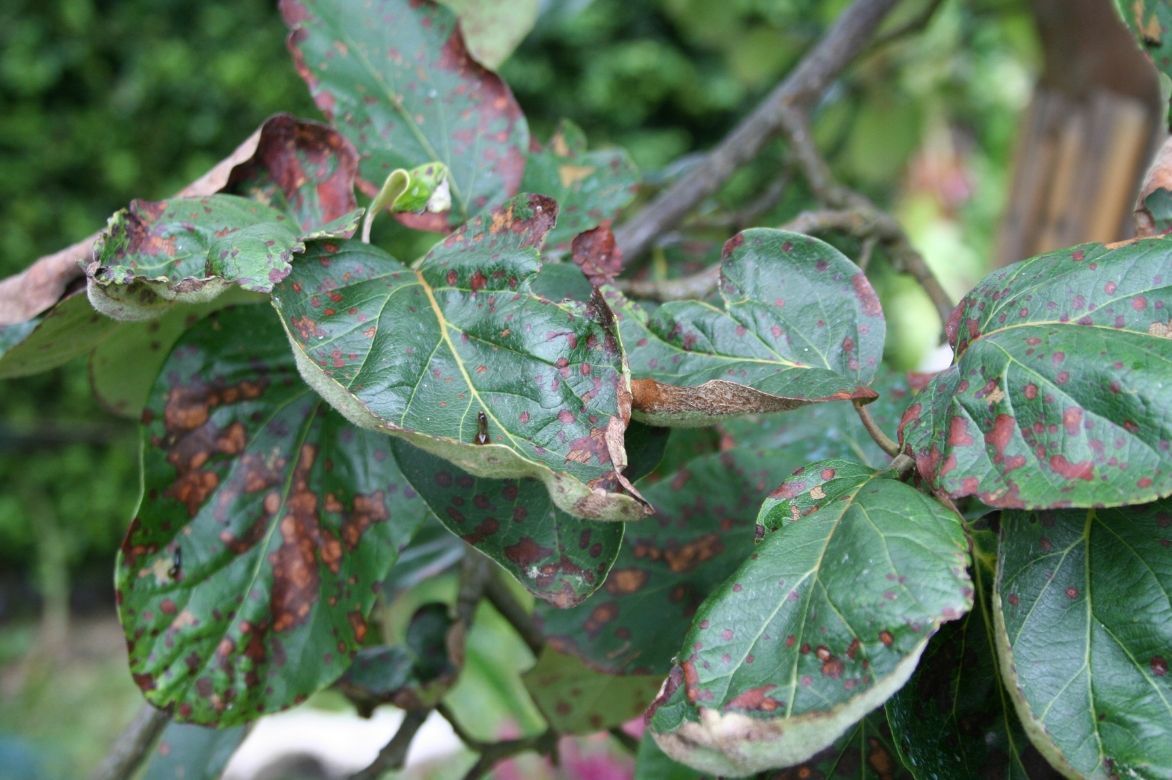
Entomosporiosis on a quince tree
It can also be affected by brown rot, which causes browning of young fruit, drying of shoot tips and even fruit rot in storage. Remove affected fruit and shoots. In both cases, spray a horsetail decoction at time of flowering and apply copper‑based treatments such as Bordeaux mixture after leaf fall and just before bud burst period. Apple scab and powdery mildew also sometimes infect quince trees.
If attacked by aphids, spray water mixed with black soap. Larvae of the codling moth or of the oriental fruit moth are sometimes present in quinces but do not necessarily require treatment when yield is substantial.
⇒ For more information: Diseases and pests of quince trees
Pruning quince trees
- When training to an open‑centred form, ensure main scaffold branches are evenly distributed around trunk and balance their length;
- Remove branches that cross or grow inward into the crown.
- Remove weak and cankered shoots as well as any suckers at the base.
- For espaliers, cut back two‑thirds of shoots each year.
→ Learn more about pruning quince trees in our tutorial!
Propagation: layering, grafting
The simplest propagation method is layering on coppice shoots. Grafting is reserved for most experienced gardeners.
Layering on coppice shoots
- Only if your young plant is not grafted and has basal suckers, mound soil around the base to a height of 30-40 cm using a mix of soil (or turf) combined with sand to encourage roots to form along the shoots.
- Separate these the following spring, or the spring after if necessary, once rootlets have appeared before detaching the layered shoots.
Note: You can also pull off suckers without roots and plant them in worked soil so they take root.
Grafting
Perform a shield graft between 15 July and 15 August on a quince or a pear grown from sowing.
Uses and associations
Like apple and pear trees, quince makes a very attractive specimen in a lawn or in an orchard, with its spreading shape, decorative bark and slightly twisted branches. But its medium size also allows it to be successfully included in an original fruiting hedge made up of a few medlars and Montmorency sour cherry trees with an understorey of pomegranates, feijoas, hazels, strawberry trees and quince trees that you prune twice a year to 1 m high. You can also pair it with hawthorn, Amelanchier, wisteria or roses that flower at the same time and will create a most romantic scene… Its Japonising habit also creates lovely scenes alongside azaleas, Japanese maples, flowering plums, peonies…

An idea for an association in a fruit hedge: Prunus cerasus subp. acida (Montmorency sour cherry), Mespilus germanica (medlar), Amelanchier laevis (or lamarckii), Corylus avellana (hazel), Arbutus unedo (strawberry tree) and Cydonia obonga (quince)
For further reading
- Discover our range of quince trees.
- Find out more Which fruit trees and fruit bushes to plant in clay soil?
- Browse our tutorial : How to prune and espalier a Japanese quince?
- Discover how to choose the right quince tree variety?
- Our advice sheet : Why isn’t my quince tree producing quinces?
- Subscribe!
- Contents
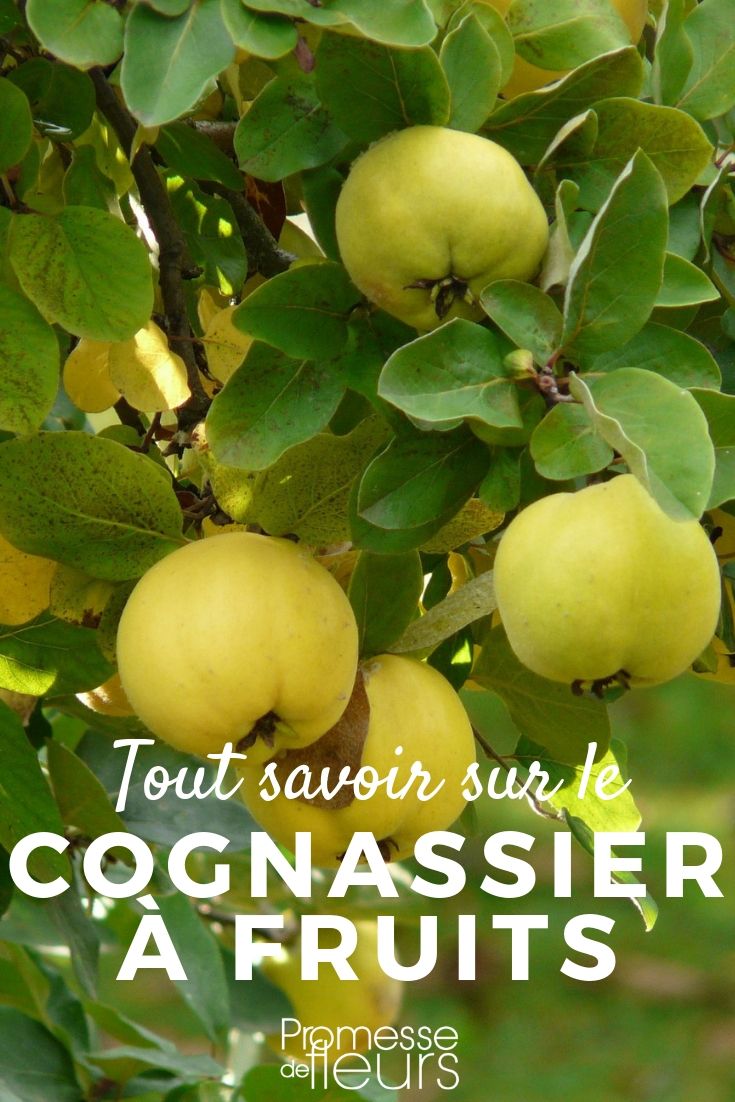































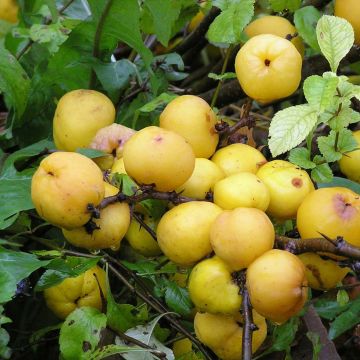

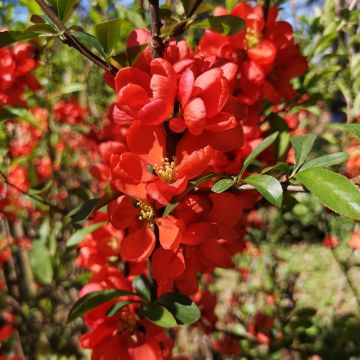
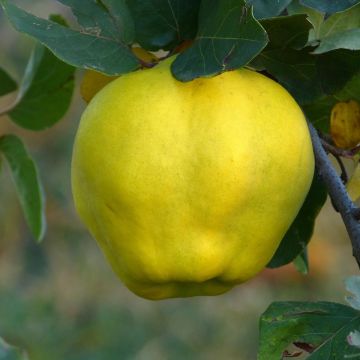

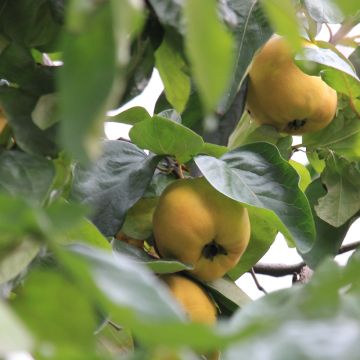
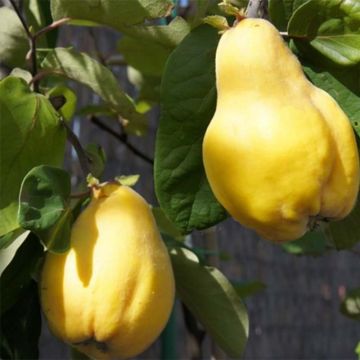
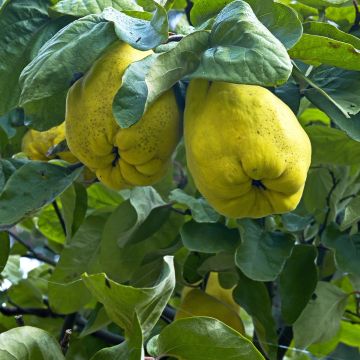
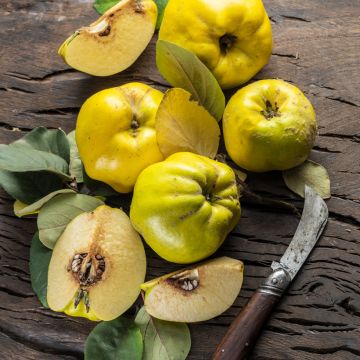
Comments